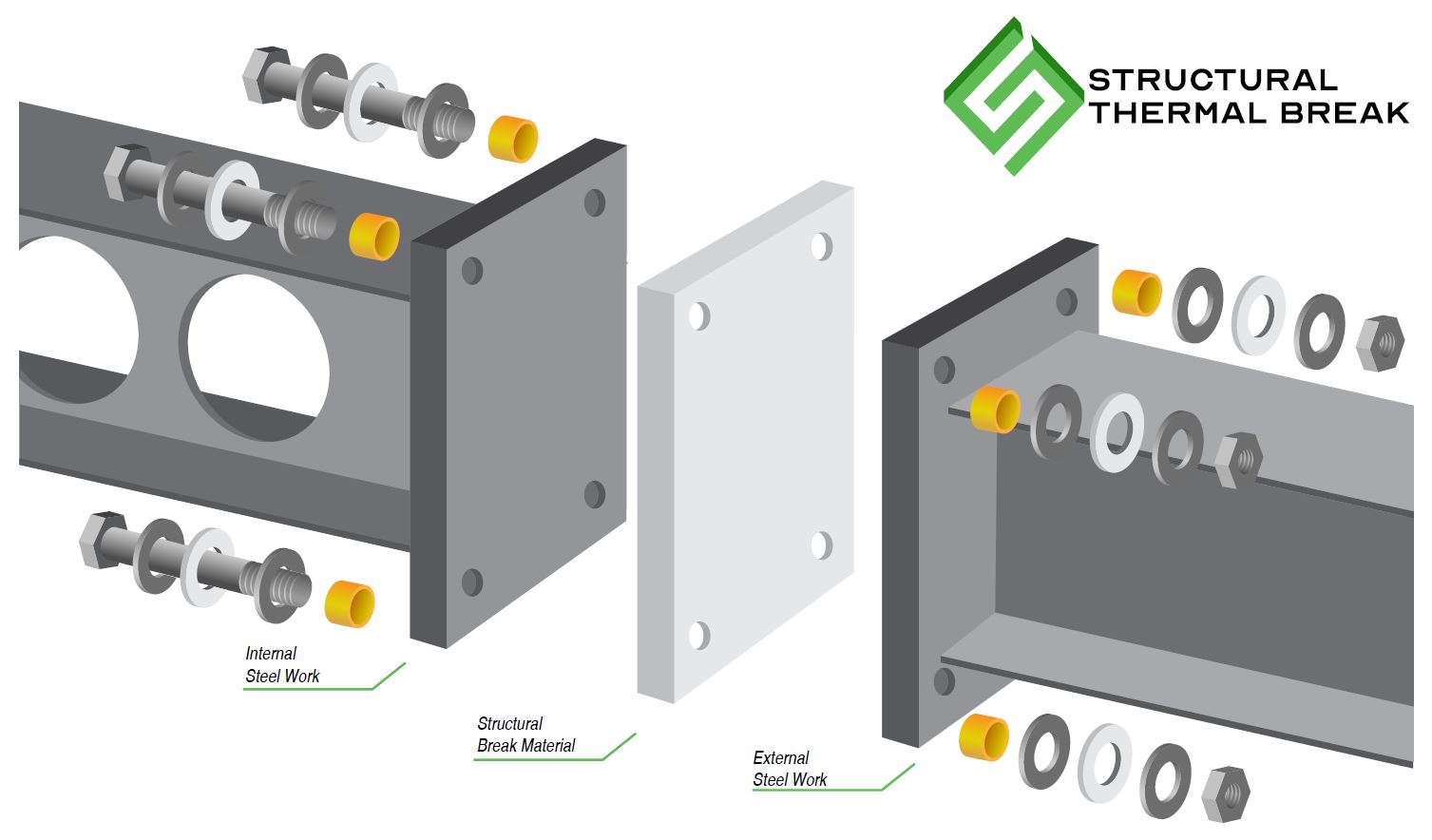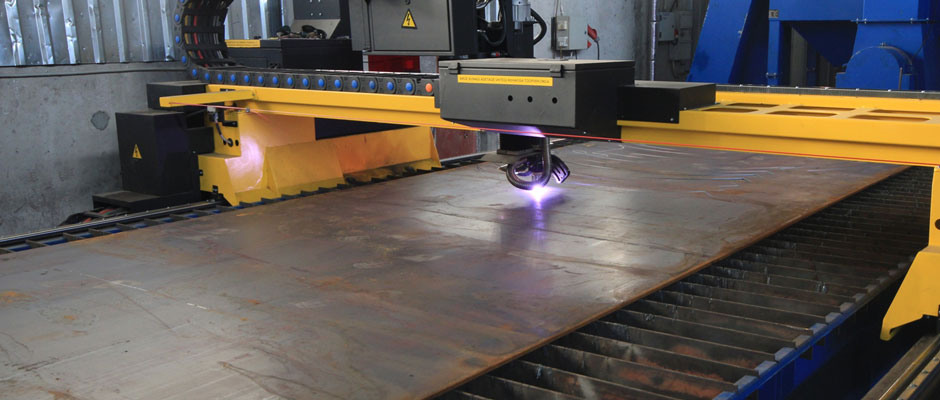
The purpose of thermal break materials and systems (thermal breaks) is to reduce the impact of thermal bridging by preventing conductive heat flow through the thermal envelope. Thermal breaks keep the heat in and push the dew point out. They break the bridge.
Research has shown that thermal bridging can increase the whole-building conductive heat loss by more than 15%. The percentage is a function of the following variables: climate, building type, location and type of the thermal bridges. The magnitude and quantity of the thermal bridging is a large factor. Some interface details increase the U value of a wall by 45% or more, other transition details increase the U value by only 5%.
STB-1 Structural Thermal Break is available in stock in Canada for fast delivery anywhere!
Typically in urgent situations STB-1 Structural Thermal Break can ship in as little as 24 hours!
STB-1 Thermal Break Pads are often called Thermal Bridges, balcony isolators, structural thermal breaks, cantilever steelwork thermal bridging, cold bridge isolation, thermal partitions, steelwork thermal break, thermal bridging, cold bridging pads, cold bridging solutions. All of these solutions use Thermal Insulation Material to prevent thermal bridging.
A complete STB-1 Structural Thermal Break system include a thermal break pad, 2 thermal break washers, 2 thermal break bushings and 4 USS Grade 8 steel washers.
With more code changes coming into play each year to protect the future of the construction industry, STB-1 Structural Thermal Break can be used in renovation projects to rectify a number of poorly isolated connections within existing buildings, as well as structures under construction to make them as efficient as possible. To achieve this and work towards making any building as efficient as possible, these solutions need to be considered within the earliest stages of a construction project, which is why it’s imperative for architects to understand the importance of these products and how they can help a structure meet certain efficiency criteria.
When using STB-1 Structural Thermal Break pads in a parapet roof location, the U value of the roof assembly will be improved, and the potential chances of condensation problems occurring will be prevented at the structural connection.
STB-1 Structural Thermal Break is a structural high performance thermal break material which delivers thermal insulation between interior and exterior steelwork, and / or concrete, to prevent thermal bridging. STB-1 Structural Thermal Break can help work towards improving building envelope performance, dramatically reducing heat loss and preventing surface condensation from forming inside the building that can be caused by cold transfer meeting warm air.
The thermal conductivity of a material is a function of its conductance which helps determine the rate at which heat flows through that material. Heat flow is also dependent on area and temperature.
Conductance is a function of thickness, so to be effective at reducing heat flow through a bolted, steel connection, the thickness of the thermal break is important.
STB-1 Structural Thermal Break material is available in several thicknesses to accommodate a wide range of connection details. In any connection design, the goal is to use the appropriate thickness/area which helps meet energy code requirements for the wall or roof assembly.
STB-1 Structural Thermal Break concrete connections address high risk structural steel connections and the thermal loss they create.
Mechanical Properties STB-1
Tensile Strength
PSI (MPa)
ASTM D638
11,000 (75.8)
Flexural Strength
PSI (MPa)
ASTM D790
25,000 (172.4)
Compressive Strength
PSI (MPa)
ASTM D695
48,000 (330.9)
Compressive Modulus - 1/2" (12.7 mm) thick
PSI (MPa)
ASTM D695
291,194 (2,007.7)
Compressive Modulus - 1" (25.4 mm) thick
PSI (MPa)
ASTM D695
519,531 (3,582.0)
Shear Strength
PSI (MPa)
ASTM D732
15,000 (103.4)
Operating Temperature Range
*Loss in Ultimate Property Strength = 30% at 250 F
F (C)
-
-20 to +250
(-29 to + 121)
Thickness
Inch (MM)
-
1/4, 1/2, 3/4, 1. 2
(6.4, 12.7, 19.1, 25.4, 50.8)
Flame Resistance (Nominal)
Oxygen Index
% O2
ASTM D2863
21.8
Thermal Properties (Nominal)
Coefficient of Thermal Expansion
in/in/Cx10-5
ASTM D696
2.2
Thermal Conductivity
BTU/Hr/ft2/in/F
ASTM C177
1.8
Density
lb/ft3 (Kg/M3)
115 (1842)
**Reference: Thermal Conductivity of Steel
BTU/Hr/ft2/in/F (W/m*K)
374.5 (54.0)
Physical Properties
Barcol Hardness
Barcol
Scale
48
Water Absorption, %
D-229
%
0.35
UL Flammability
UL94
Class
HB
Flame Resistance, Seconds
Ignition Time
Burning Time
D-229
D-229
Seconds
Seconds
103
211
Mechanical Properties
Modulus of Elasticity in Flexure
PSI D-790
PSI
1.6 x 106
Bond Strength, 1/2" Thickness, PSI
D-229
PSI
1,200
Impact Strength, Izod Edgewise
D-256
Ft lbs / In. Notch
8.5
Electrical Properties
Dielectric Strength, Short Time in Oil 1/16", VPM
D-149
VPM
500
Dielectric Strength, Parallel, Step By Step In Oil, KV
D-149
KV
60.0
Arc Resistance, Seconds
D-495
Seconds
150
Dielectric Constant @60HZ
D-150
4.8
Dissipation Factor @ 60HZ
D-150
0.02
Unless otherwise indicated, all properties published are based on test performed on standard ASTM test samples and according to ASTM test methods. Values shown are for test samples made from production materials and they are believed to be conservative. No warranty is to be construed, however, in fabricated or molded form, parts may vary considerably from this standard test data.
Benchmark accepts no responsibility for individual results obtained. Everyone is strongly recommended to verify data and obtain their own independent test results. This data is subject to change without notice.
Typical STB-1 Structural Thermal Break Connection
Structural Thermal Break (STB-1) is available in thickness of 1/4", 1/2", 3/4", 1"and 2". In any connection design using a thermal break, the goal is to find the appropriate thickness and area combination that helps the wall or roof assembly meet the U value requirement based on climate zone and energy code.
Structural Thermal Break (STB-1) reduces heat loss at balcony, canopy, shelf angle, roof post and other structural connections.
Structural Thermal Break (STB-1) is a thermoset, reinforced composite. It can transfer loading conditions up to 48,000 psi and has very good fire properties. The material has been designed to form a char when exposed to flame and reduce the amount of oxygen available to a fire.

Please fill out the below form to receive more information about STB-1 Structural Thermal Break.
Our typical response time is under 2 hours.
Additional Thermal Break and Vibration control products we stock in Canada for fast fabrication and shipment:
The Benchmark machining process:
Benchmark employs a variety of state of the art machining processes to fabricate STB-1 Structural Thermal Break Pads, Vibsorb Vibration Absorption Pads, PTFE Slide Bearings, Vibsorb Elastomeric Bearings and Vibsorb Expansion Bearings.
Depending on the material being cut or bonded Benchmark will use CNC Router Machines, Waterjet Cutters, CNC Laser, Hydraulic Presses and more. Since we keep many of these machines "in house" we are able to dramatically reduce our processing time compared to alternative products.
Please call 800 580 4195 or email us today for engineer / architect design packages or data sheets for any of our Structural Thermal Break or Vibration Control Systems.






